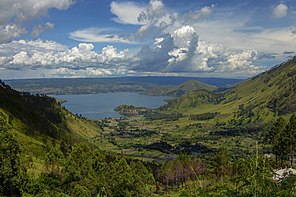
Back Tobameer Afrikaans بحيرة توبا Arabic Toba gölü Azerbaijani Danu Toba BAN Tao Toba BBC Тоба Byelorussian Тоба (езеро) Bulgarian টোবা হ্রদ Bengali/Bangla Llac Toba Catalan Danau Toba CEB
| Lake Toba | |
|---|---|
| Danau Toba (Indonesian) | |
 A view of Lake Toba and Samosir Island | |
| Location | Balige, North Sumatra |
| Coordinates | 2°41′N 98°53′E / 2.68°N 98.88°E |
| Type | Volcanic/tectonic |
| Part of | Asahan Toba basin |
| Primary outflows | Asahan River |
| Basin countries | |
| Max. length | 100 km (62 mi) |
| Max. width | 30 km (19 mi) |
| Surface area | 1,130 km2 (440 sq mi) |
| Average depth | 216 m (709 ft) |
| Max. depth | 505 m (1,657 ft)[1] |
| Water volume | 244 km3 (59 cu mi) |
| Surface elevation | 905 m (2,969 ft) |
| Islands | Samosir |
| Settlements | Ambarita, Pangururan |
| References | [1] |
Lake Toba (Indonesian: Danau Toba, Toba Batak: ᯖᯀᯬ ᯖᯬᯅ; romanized: Tao Toba) is a large natural lake in North Sumatra, Indonesia, occupying the caldera of the Toba supervolcano.The lake is located in the middle of the northern part of the island of Sumatra, with a surface elevation of about 900 metres (2,953 ft), the lake stretches from 2°53′N 98°31′E / 2.88°N 98.52°E to 2°21′N 99°06′E / 2.35°N 99.1°E. The lake is about 100 kilometres (62 miles) long, 30 kilometres (19 mi) wide, and up to 505 metres (1,657 ft) deep. It is the largest lake in Indonesia and the largest volcanic lake in the world.[1] Toba Caldera is one of twenty geoparks in Indonesia,[2] and was recognised in July 2020 as one of the UNESCO Global Geoparks.[3][4][5]
Lake Toba is the site of a supervolcanic eruption estimated at VEI 8 that occurred 69,000 to 77,000 years ago,[6][7][8] representing a climate-changing event. Recent advances in dating methods suggest a more accurate identification of 74,000 years ago as the date.[9] It is the largest-known explosive eruption on Earth in the last 25 million years. According to the Toba catastrophe theory, the eruption had global consequences for human populations as it killed most humans living at that time and is believed to have created a population bottleneck in central east Africa and India, which affects the genetic make-up of the human worldwide population to the present.[10] More recent studies had cast doubt on this theory and found no evidence of substantial changes in global population.[11]
It was also suggested that the eruption of the Toba Caldera led to a volcanic winter with a worldwide decrease in temperature between 3 and 5 °C (5.4 and 9.0 °F), and up to 15 °C (27 °F) in higher latitudes. Additional studies in Lake Malawi in East Africa show significant amounts of ash being deposited from the Toba Caldera eruptions, even at that great distance, but little indication of a significant climatic effect in East Africa.[12]
- ^ a b c "LakeNet – Lakes".
- ^ "Gov't Expects UNESCO to Recognize Kaldera Toba Geopark This Year". Tempo. Retrieved 16 July 2018.
- ^ Gunawan, Apriadi (8 July 2020). "Toba caldera finally recognized as UNESCO Global Geopark". The Jakarta Post. Retrieved 9 July 2020.
- ^ "Lake Toba proposed as world geopark heritage site". The Jakarta Post. Retrieved 16 July 2018.
- ^ "Perjalanan Geopark Kaldera Danau Toba Masuk Daftar UGG". Kompas. Retrieved 16 July 2018.
- ^ "Toba: General Information". Global Volcanism Program. Smithsonian Institution. Retrieved 24 June 2021.
- ^ Cite error: The named reference
chesner1991was invoked but never defined (see the help page). - ^ Ninkovich, D.; N.J. Shackleton; A.A. Abdel-Monem; J.D. Obradovich; G. Izett (7 December 1978). "K−Ar age of the late Pleistocene eruption of Toba, north Sumatra". Nature. 276 (5688). Nature Publishing Group: 574–577. Bibcode:1978Natur.276..574N. doi:10.1038/276574a0. S2CID 4364788.
- ^ Vogel, Gretchen, How ancient humans survived global ‘volcanic winter’ from massive eruption, Science, 12 March 2018
- ^ "When humans faced extinction". BBC. 9 June 2003. Retrieved 5 January 2007.
- ^ Yost, Chad L.; Jackson, Lily J.; Stone, Jeffery R.; Cohen, Andrew S. (March 2018). "Subdecadal phytolith and charcoal records from Lake Malawi, East Africa imply minimal effects on human evolution from the ~74 ka Toba supereruption". Journal of Human Evolution. 116: 75–94. doi:10.1016/j.jhevol.2017.11.005. PMID 29477183. Retrieved 1 August 2020.
- ^ Lane, Christine S.; Ben T. Chorn; Thomas C. Johnson (29 April 2013). "Ash from the Toba supereruption in Lake Malawi shows no volcanic winter in East Africa at 75 ka". Proceedings of the National Academy of Sciences. 110 (20): 8025–8029. Bibcode:2013PNAS..110.8025L. doi:10.1073/pnas.1301474110. PMC 3657767. PMID 23630269.
© MMXXIII Rich X Search. We shall prevail. All rights reserved. Rich X Search

